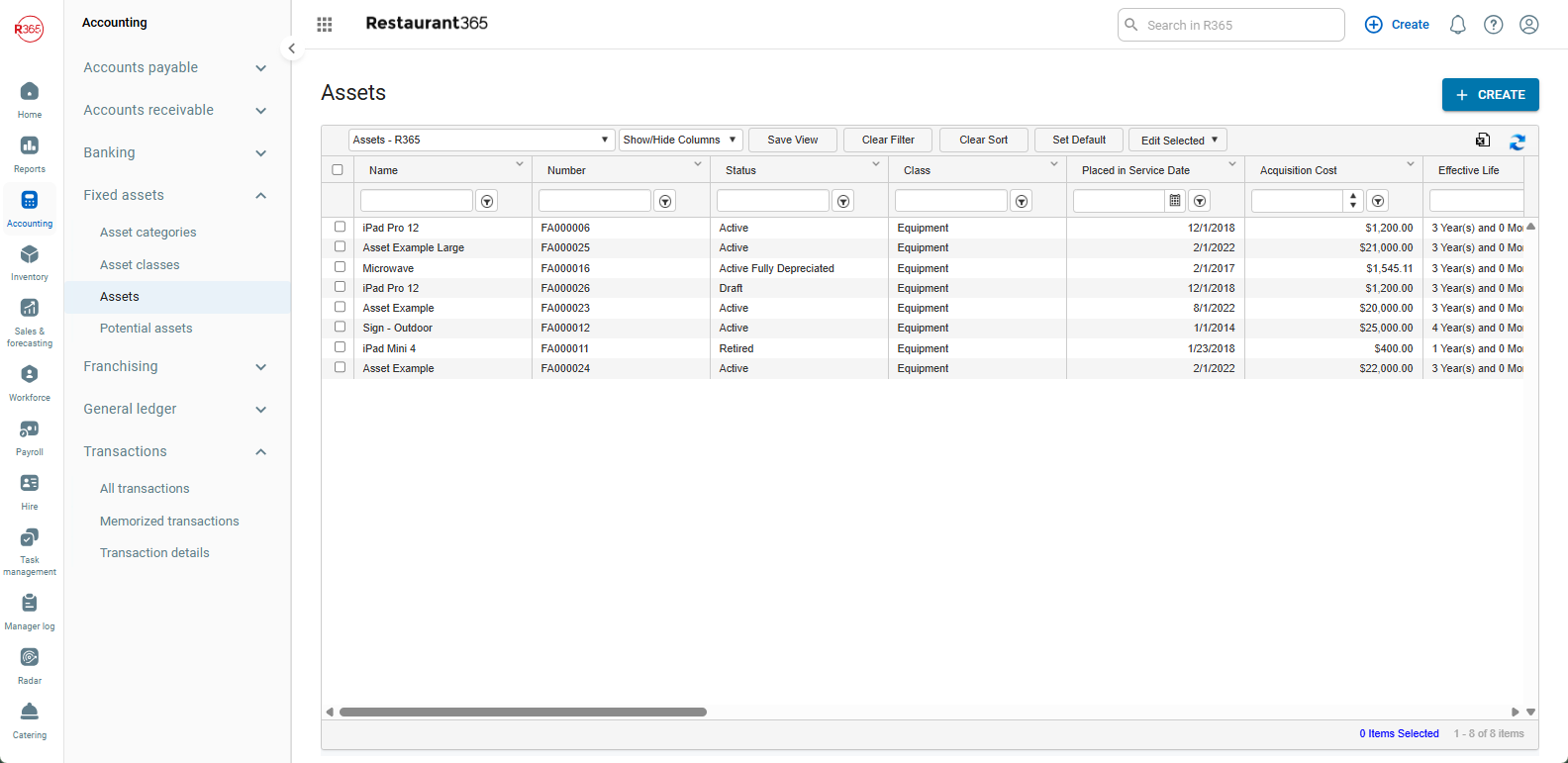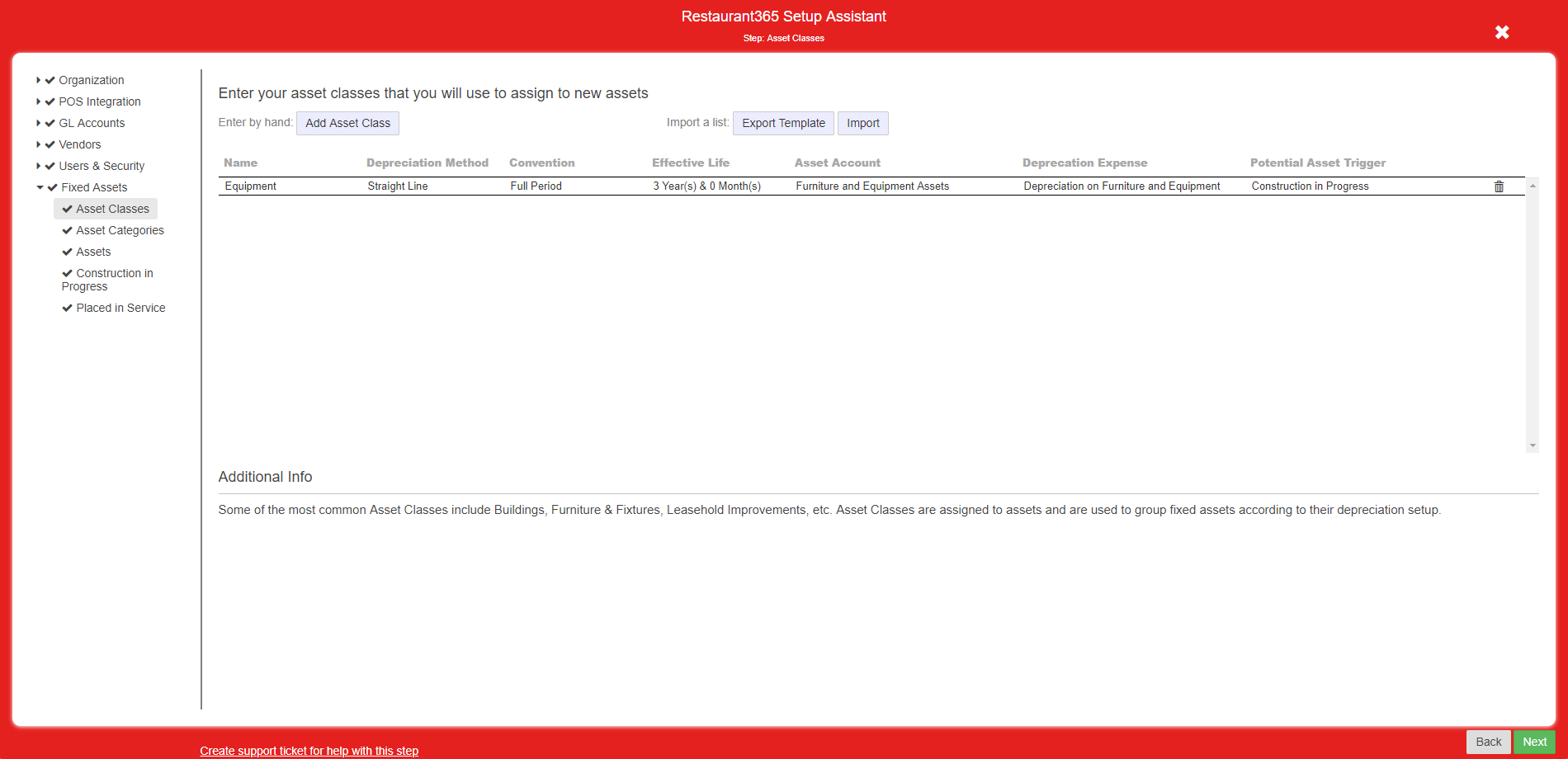The Fixed Assets section of the Accounting module allows users to track fixed assets in R365. Fixed assets can be any physical item that resides at a location long-term. The Assets page is used to track these items.
For example, a location purchased a grill for $2000. The manager records the purchase of the grill by creating an asset record. The Placed In Service Date is also recorded, and the asset is marked as Active. The manager accesses the deprecation form to retire the old grill after the new one is installed.
Fixed assets can be automatically deprecated after a set amount of time based on configured classes and categories.
If Fixed Assets is not available in the left navigation menu, please contact your R365 Sales Rep or R365 Support to enable the Fixed Assets.

Security
The permissions listed here are associated with Fixed Assets. These permissions can be added to custom user roles or individual users. Learn more about managing permissions and custom user roles here.
Fixed Asset permissions are found in the permission tree as follows:
Fixed Assets
Asset Categories
View Asset Categories
Edit Asset Categories
Create Asset Categories
Delete Asset Categories
Asset Classes
View Asset Classes
Edit Asset Classes
Create Asset Classes
Delete Asset Classes
Assets
View Assets
View & Modify Potential Assets
Edit Assets
Create Assets
Delete Assets
Depreciation
Post Asset Depreciation
The Permission Access report can be used to determine which user roles or users already have these permissions assigned.
Learn more about User Setup and Security here.
Users will need access to each location that will be used for asset management. An Asset Manager will not be able to assign an asset to a location that they do not have access to. Click here for more information on User Location Access setup.
Getting Started
When Fixed Assets enabled, the Asset Manager completes configurations in the R365 Setup Assistant. The logical flow in the Setup Assistant aids the Asset Manager in completing each step, as well as any required prerequisites, before entering or importing asset records.

Asset Classes
All assets must belong to an asset class. Asset classes act as templates for importing or manually creating new assets. An asset can only have one asset class. For more information, see Asset Classes.
Asset Categories
Asset Categories allow you to create an additional reporting level for your Assets. Categories are User-defined and allow you to group different Assets into specific categories for reporting purposes. Assets can have multiple Asset Categories. For more information, see Asset Categories.
Assets
Your Assets are the key record in the Fixed Assets Module. Assets can exist with several different statuses, including:
Draft
Construction in Progress (CIP)
Non-Depreciating Assets (Active)
Placed In Service (Active)
Fully Depreciated (Active Fully Depreciated)
Retired
For more information, see the following articles:
Asset Tag Printout
Through the Asset Tag Printout report, you can generate a printout that can be used with standard address labels to physically tag your Assets. For more information, see Asset Tag Printout.
Potential Assets
On each Asset Class, you can assign a 'Potential Asset Trigger' Account. Any time an AP Invoice or Journal Entry includes transaction details recorded on the designated Account, the transaction will be filtered into the 'Potential Assets' list where your Asset Manager can review and classify each transaction. For more information, see Potential Assets.
Fixed Asset Reporting
Several Asset Reports have been created for the Fixed Asset Module. For more information, see Fixed Asset Reporting.
Asset Depreciation: Reviewing & Posting Depreciation
The Fixed Asset Module will automatically calculate Depreciation for all of your Depreciating Fixed Assets for the duration of their useful lives. Before the close of each Period, your Fixed Asset Manager can use the Fixed Asset Depreciation review screen to preview the Depreciation that will post for each active Asset for the Period. When everything has been reviewed, the Fixed Asset Manager can post the Depreciation with a single click. For more information, see Depreciation Form.